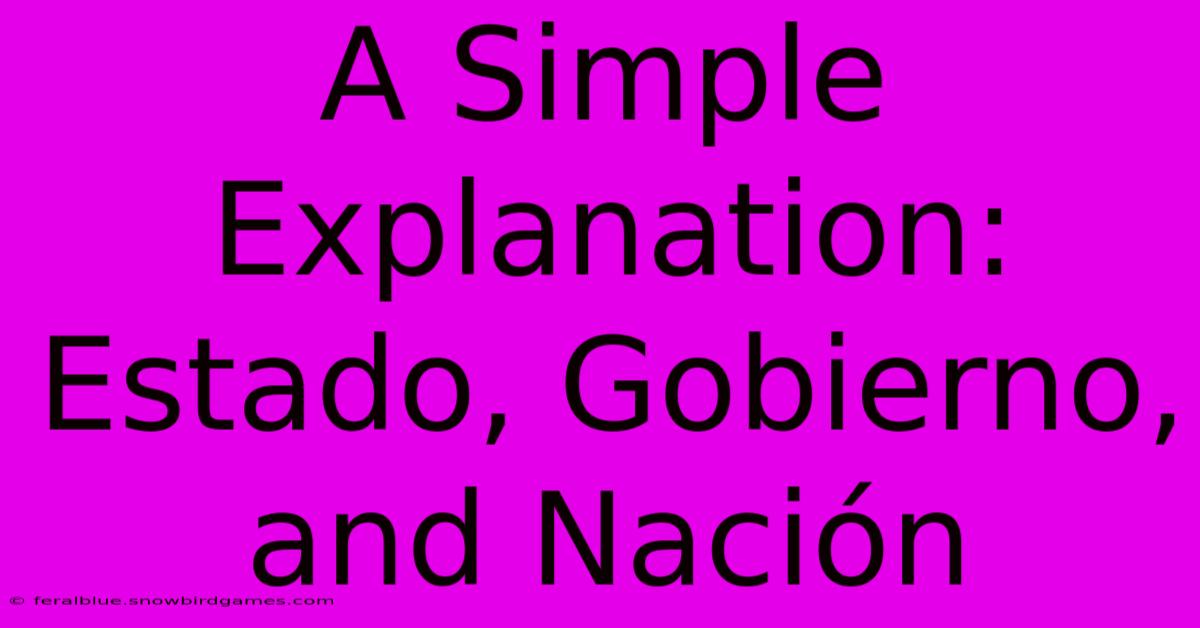A Simple Explanation: Estado, Gobierno, And Nación

Table of Contents
A Simple Explanation: Estado, Gobierno, and Nación
Understanding the differences between Estado, Gobierno, and Nación can be tricky, even for native Spanish speakers. These three terms are often used interchangeably in casual conversation, but in political science and legal contexts, they represent distinct concepts. This article aims to clarify these distinctions with simple explanations and examples.
What is Estado (State)?
The Estado, often translated as "State," refers to the permanent institutional structure of a political entity. It encompasses the entire apparatus of government, including:
- Territory: A defined geographical area under its control.
- Population: The people residing within its territory.
- Sovereignty: The supreme authority within its territory, free from external control.
- Government: The administrative body responsible for carrying out the State's functions (more on this below).
- Legal System: The laws and institutions that govern the State and its citizens.
Think of the Estado as the building itself, a permanent structure, regardless of who is currently living or working within it. It represents the abstract legal entity possessing sovereignty. The United States, France, or Mexico are all examples of Estados.
Key Characteristics of the Estado:
- Permanence: It exists continuously, even if governments change.
- Sovereignty: It holds supreme authority within its borders.
- Legality: It operates under a defined legal framework.
- Monopoly on Force: It holds a legitimate monopoly on the use of force within its territory.
What is Gobierno (Government)?
The Gobierno, translated as "Government," refers to the group of people who currently exercise power within the Estado. It's the temporary administrative body responsible for implementing the policies and laws of the State. The Gobierno is the occupancy of the building.
The composition and structure of the Gobierno vary depending on the political system. It could be a democracy, a monarchy, a dictatorship, or any other form of governance. The Gobierno changes through elections, coups, or other political processes.
Key Characteristics of the Gobierno:
- Temporary: It is not permanent and can change frequently.
- Executive Power: Primarily focused on implementing laws and policies.
- Accountability: Ideally, it is accountable to the people or a higher authority.
- Dynamic: Its composition and actions change according to political circumstances.
What is Nación (Nation)?
The Nación, often translated as "Nation," refers to a group of people who share a common cultural identity. This shared identity can encompass:
- Language: A common language or dialect.
- History: A shared historical narrative and experience.
- Culture: Similar traditions, customs, values, and beliefs.
- Territory: A connection to a particular territory (though this is not always necessary).
The Nación is a community of feeling and belonging, defined by shared cultural traits rather than legal or political structures. It's important to note that a Nación doesn't necessarily correspond to the boundaries of a Estado. Many nations exist across multiple states (e.g., the Kurdish nation), and many states contain multiple nations (e.g., Canada).
Key Characteristics of the Nación:
- Cultural Identity: Defined by shared cultural attributes.
- Shared History: A collective understanding of the past.
- Collective Identity: A sense of belonging and solidarity among members.
- Dynamic: It evolves over time, but core cultural elements remain.
The Interplay of Estado, Gobierno, and Nación
While distinct, these three concepts are interconnected. The Gobierno operates within the Estado, which aims to represent the interests of the Nación. However, the relationship between them is often complex and sometimes strained. A government might not effectively represent all the nations within its state, or a nation might aspire to establish its own state. Understanding these nuances is key to comprehending political dynamics and conflicts worldwide.
In Conclusion: Estado, Gobierno, and Nación are distinct yet intertwined concepts. Grasping their differences is crucial for understanding political systems and the complexities of governance. This simplified explanation serves as a foundation for further exploration into these fascinating and vital topics.

Thank you for visiting our website wich cover about A Simple Explanation: Estado, Gobierno, And Nación. We hope the information provided has been useful to you. Feel free to contact us if you have any questions or need further assistance. See you next time and dont miss to bookmark.
Featured Posts
-
John Travoltas Daughter A Fashion Icon In The Making
Apr 02, 2025
-
Reborn To Fight Protecting His Daughter From Darkness
Apr 02, 2025
-
The Legacy Lives On A Fathers Perseverance
Apr 02, 2025
-
Jay Shahs Age A Critical Examination
Apr 02, 2025
-
What You Need To Know About Ddgs Net Worth
Apr 02, 2025
